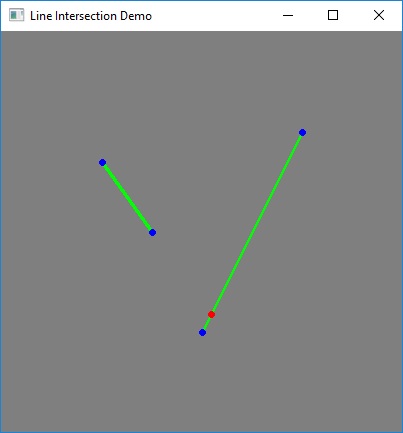This forum is disabled, please visit https://forum.opencv.org
 | 1 | initial version |
there is some (internal) helper functions in min_enclosing_triangle.cpp

#include "opencv2/imgproc.hpp"
#include "opencv2/highgui.hpp"
#include <iostream>
using namespace cv;
using namespace std;
#define EPSILON 1E-5
//! Return the maximum of the provided numbers
static double maximum(double number1, double number2, double number3) {
return std::max(std::max(number1, number2), number3);
}
//! Check if the two numbers are equal (almost)
/*!
* The expression for determining if two real numbers are equal is:
* if (Abs(x - y) <= EPSILON * Max(1.0f, Abs(x), Abs(y))).
*
* @param number1 First number
* @param number2 Second number
*/
static bool almostEqual(double number1, double number2) {
return (std::abs(number1 - number2) <= (EPSILON * maximum(1.0, std::abs(number1), std::abs(number2))));
}
//! Determine the intersection point of two lines, if this point exists
/*! Two lines intersect if they are not parallel (Parallel lines intersect at
* +/- infinity, but we do not consider this case here).
*
* The lines are specified by a pair of points each. If they intersect, then
* the function returns true, else it returns false.
*
* Lines can be specified in the following form:
* A1x + B1x = C1
* A2x + B2x = C2
*
* If det (= A1*B2 - A2*B1) == 0, then lines are parallel
* else they intersect
*
* If they intersect, then let us denote the intersection point with P(x, y) where:
* x = (C1*B2 - C2*B1) / (det)
* y = (C2*A1 - C1*A2) / (det)
*
* @param a1 First point for determining the first line
* @param b1 Second point for determining the first line
* @param a2 First point for determining the second line
* @param b2 Second point for determining the second line
* @param intersection The intersection point, if this point exists
*/
static bool lineIntersection(const cv::Point2f &a1, const cv::Point2f &b1, const cv::Point2f &a2,
const cv::Point2f &b2, cv::Point2f &intersection) {
double A1 = b1.y - a1.y;
double B1 = a1.x - b1.x;
double C1 = (a1.x * A1) + (a1.y * B1);
double A2 = b2.y - a2.y;
double B2 = a2.x - b2.x;
double C2 = (a2.x * A2) + (a2.y * B2);
double det = (A1 * B2) - (A2 * B1);
if (!almostEqual(det, 0)) {
intersection.x = static_cast<float>(((C1 * B2) - (C2 * B1)) / (det));
intersection.y = static_cast<float>(((C2 * A1) - (C1 * A2)) / (det));
return true;
}
return false;
}
int main(int argc, char** argv)
{
Mat img(400, 400, CV_8UC3, Scalar(127, 127, 127));
Point2f p1(100,130), p2(150,200), p3(300,100), p4(200,300), intersection_point;
line(img, p1, p2, Scalar(0, 255, 0), 2);
line(img, p3, p4, Scalar(0, 255, 0), 2);
lineIntersection(p1, p2, p3, p4, intersection_point);
circle(img, intersection_point, 2, Scalar(0, 0, 255), 2);
circle(img, p1, 2, Scalar(255, 0, 0), 2);
circle(img, p2, 2, Scalar(255, 0, 0), 2);
circle(img, p3, 2, Scalar(255, 0, 0), 2);
circle(img, p4, 2, Scalar(255, 0, 0), 2);
imshow("Line Intersection Demo", img);
waitKey(0);
return 0;
}